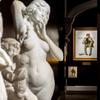Art Depicting Art: "Oedipus Rex" by Renoir
- December 02, 2013 14:36
In 1895, Renoir was commissioned to paint a series of paintings to decorate the home of the director of the Theatre des Varietes, Paul Gallimard. Perhaps one of the best loved Impressionists of all time, Renoir was renowned for capturing all of his subjects with grace and sensuality and Gallimard, a patron and friend of the artist, thought the artist’s work a perfect fit for his homes in Paris and Normandy. Revered for his figures, still-lives, and landscapes, Renoir chose a theatrical subject for the director’s homes. Encouraged by his friend, the actor Mounet-Sully, Renoir did a series of sketches and paintings depicting a quintessential highly-charged and dramatic moment in theater. The result was this remarkable painting, an awe-inspiring and dynamic canvas depicting Mounet-Sully in his most famous role as Oedipus in L’Oedipe Roi, a French version by Jules Lacroix of Sophocles’ iconic Greek drama.
In this painting Oedipus, having gouged out his eyes after learning of his despicable crimes, is seen groping his way out of the palace, as his subjects look on in terror. Known for his idyllic landscapes and softly painted portraits, Renoir’s 1895 painting, Oedipus Rex, is an incredibly unique and dramatic subject choice for the artist. This exceptional painting depicts a pivotal scene from the Greek tragedy - the final scene of the drama as Oedipus exits the palace confronting the citizens of Thebes. This intimate masterpiece displays Renoir's uncanny ability to render life, movement and texture and clearly exhibits the brilliant color that the artist infused into all of his works. The exquisite tension and turmoil of the moment is depicted with Renoir's quick, feathered strokes and intuitively blended applications of pigment.
The Athenian tragedy, Oedipus Rex, was first performed in 429 B.C. and chronicles the story of Oedipus, who becomes the king of Thebes. Sentenced to die at birth because his father King Laius, receives a prophecy that he would be murdered by his own son, the infant Oedipus is left by his mother, Queen Iocaste, on a mountainside. Rescued by a shepherd, Oedipus is given to the King of Corinth who raises him as his son.
The drama continues when as a young man Oedipus is told by an oracle that he will shed the blood of his father and marry his mother. Desperate to avoid this fate, Oedipus flees Corinth and during his journey, travels on the road to Thebes and encounters Laius. Unaware of each other's identities, Laius and Oedipus quarrel over whose chariot has the right of way. The argument becomes violent and ends when Oedipus throws Laius from his chariot and kills him. Shortly after, Oedipus solves the riddle of the Sphinx freeing the kingdom of Thebes from a curse and as a result the Queen, Iocaste, marries him. At this point in the play both prophecies are fulfilled, although none of the characters are aware of it.
As the play unfolds many more incidents highlighting the futility of avoiding one’s fate occur and individual identities are revealed to the leading characters, but only after Oedipus and Iocaste have had many children together. Horrified by their relationship, Iocaste hangs herself and Oedipus blinds himself with her hairpins. It is at this point in the play that Oedipus emerges out of the palace to confront the citizens of Thebes with his blindness and to demand his exile. It is precisely this dynamic and highly charged scene that is portrayed by Renoir in this exceptional and intimate portrait.
The youngest member of the Impressionist movement, an astute Renoir recognized how a subject was constantly changing due to the dynamic effects of light on color. Capturing a particular moment in time, or an "impression," was central to the artist's philosophy and Renoir distinguished himself among his contemporaries with his intuitive use of color and expansive brushstrokes.
Sadly the project for Gallimard’s homes never came to fruition and the director never acquired the finished Renoir paintings so they remained in the artist's studio, together with several related drawings to be eventually dispersed with the artist’s estate.
Today, Renoir's work continues to increase in value and the drama of Oedipus continues to be a quintessential icon of western literary, artistic and psychological genres. Renoir's fame, as well as the classical scene and notable patronage of this particular work, make it an important and notable contribution to 19th century art.
To view M.S. Rau Antiques’ selection of original Impressionist art, click here.
About M.S. Rau Antiques:
M.S. Rau Antiques has spent over 100 years earning the trust of discerning collectors world-wide. Located in the heart of New Orleans’ historic French Quarter, our peerless showroom houses one of the world’s most extensive and stunning collections of important fine art by artists such as Monet and van Gogh, rare 18th-and 19th-century antiques and breathtaking jewelry, including rare colored diamonds.





















100x100_c.jpg)